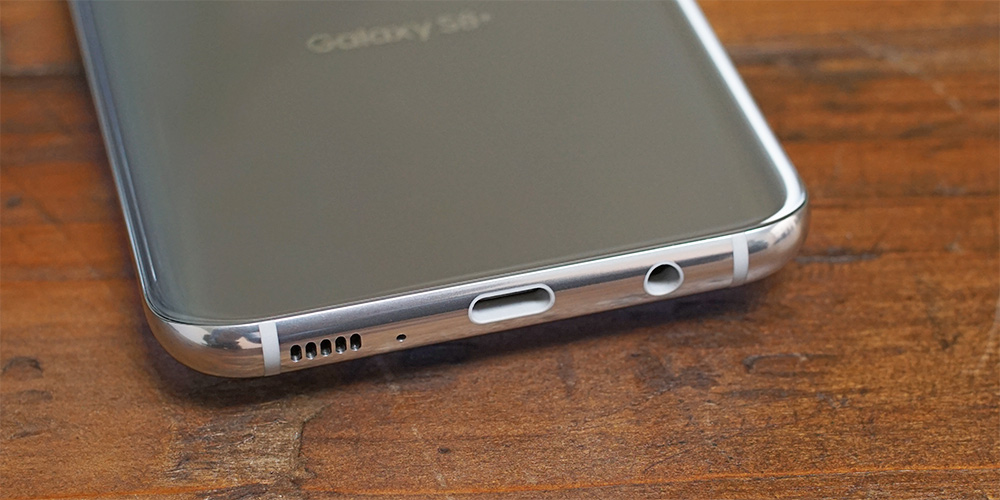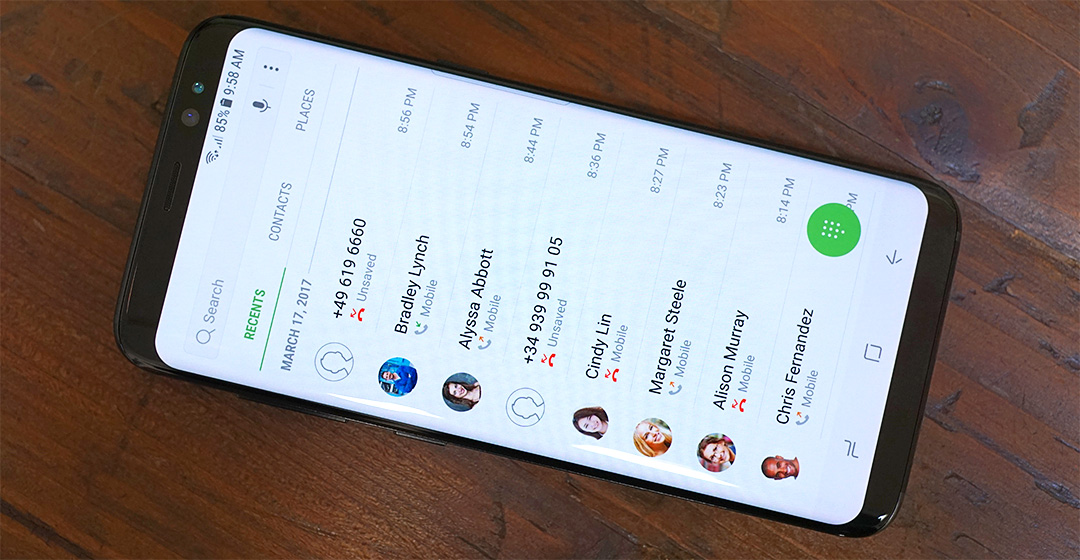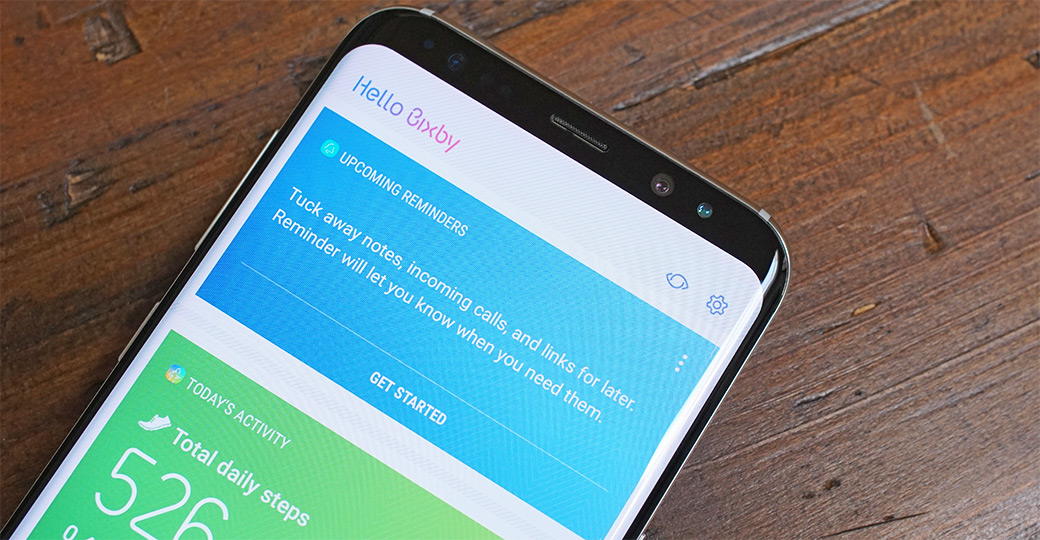Hands On With Samsung's Galaxy S8 and S8+: Taller Screens and Slimmer Bezels
by Matt Humrick on March 29, 2017 11:00 AM EST- Posted in
- Smartphones
- Samsung
- Galaxy
- Mobile
- Galaxy S8

Samsung officially unveiled the latest Galaxy devices at its Unpacked event in New York today. Previous Galaxy phones were part Porsche 911 Carrera, with an easily recognizable curvaceous style, and part Swiss Army knife, bristling with technology and features. This analogy holds true for the 5.8-inch Galaxy S8 and 6.2-inch Galaxy S8+, which share the same design DNA as the previous two generations.
The new phones’ aluminum frame remains sandwiched between edge-to-edge Corning Gorilla Glass 5, with curved sides on the front and back. The curved rear glass makes the phones easier to pick up and more comfortable to hold just as they did for the S7 and S7 edge, while the curved front glass—now standard on both S8 models—adds some visual flair.
There’s not much difference between the S8 and S7 along the sides either. The USB Type-C port on the bottom is flanked by a 3.5mm headphone jack and a single downward-firing speaker. The microSD/NanoSIM combo tray still resides on the top, and the thin power button is still a bit more than halfway up the right side. The only differences between new and old lie on the left side, where the volume buttons have been combined into a single rocker and a dedicated button for launching Samsung’s Bixby assistant makes its debut. Unlike the power button, I found myself occasionally pressing the Bixby button accidentally when picking up the smaller S8.
The most significant change is found up front, however, and it’s one that impacts both form and function. The Galaxy S8 and S8+ adopt Samsung’s new “Infinity Display” that stretches the screen vertically but not horizontally, deviating from the traditional 16:9 aspect ratio. The result is a QHD+ SAMOLED display with a 2960x1440 resolution and an 18.5:9 aspect ratio that’s very similar to the 18:9 aspect ratio display LG is using in its G6. Both Samsung and LG cite market research for this new display direction: People want larger screens that can show more content, but they also want phones that are useable with one hand and can fit in their pocket. The taller screen fits more content, so less scrolling, but keeps the phone narrow, so it’s easier to wrap your hand around.
Both S8 phones incorporate another emerging design trend: rounded display corners. Where LG’s G6 is using an LCD panel that actually has rounded corners, it appears Samsung is using a rounded bezel to cover the S8’s still sharp-cornered display. This avoids the aliasing that’s evident in the G6’s corners, producing a much smoother, nicer looking effect. While my time with the S8 was limited, it appears that TouchWiz and Samsung’s apps were redesigned to account for the rounded corners: Backgrounds extend the full height of the display and visual elements are still displayed along the top and bottom edges without getting cut off. Third-party apps, however, find their vertical dimensions constrained to the purely rectangular portion of the display, with the status bar above and the navigation bar below taking on black backgrounds.
The S8 and S8+ are also the first phones to receive the UHD Alliance’s Mobile HDR Premium certification that ensures a mobile device meets the minimum requirements for playback of 4K HDR video. This means that both S8s are capable of rendering at least 90% of the DCI-P3 color gamut, have a dynamic range of at least 0.0005-540 nits, and support a 10-bit display pipeline.
To keep the overall size of the phones in check, the S8/S8+ and G6 have dramatically reduced the bezel area around the taller screens. Samsung claims a screen-to-body ratio of 83% for its new Galaxy phones, less than the 91.3% of Xiaomi’s Mi MIX concept phone, but impressive nonetheless, especially considering how much hardware is located in the S8’s upper bezel. Besides the usual earpiece and proximity/ambient light sensors, there’s a new 8MP front-facing camera with f/1.7 lens and Smart AF that uses facial recognition for accurate focusing when taking selfies. There’s also an IR LED and IR camera for the iris-scanning security feature that made its debut on the ill-fated Galaxy Note7.
Shrinking the size of the lower bezel required relocating the fingerprint sensor to the back. Instead of placing it below the rear camera like we see on most other phones, Samsung places it next to the flush-mounted camera, which is less than ideal. Both the camera and the sensor are surrounded by a raised lip and are similar in size, making it difficult to locate the sensor by feel, and if your finger misses the sensor, you end up with a nice fingerprint on the camera lens. On the smaller S8, this issue may be mitigated with practice, but the problem is worse for the S8+. Being taller, it places the camera and sensor further from the lower edge, making it very difficult, if not impossible, to reach the sensor when holding the phone with a natural grip. Even with my larger-than-average hands, I struggled to reach the sensor without shifting my grip. I suspect people will turn to the iris scanner or the new face unlock feature, which uses the front camera for facial recognition after pressing the power button, to overcome the poor fingerprint sensor placement. The physical home button and capacitive navigation buttons, iconic Galaxy design features, have also been evicted in favor of the slimmer bezel, replaced by onscreen controls.



















208 Comments
View All Comments
Reflex - Thursday, March 30, 2017 - link
That is not actually true in practice. LiPO batteries were not adopted more quickly because they have lower energy density. As power efficiency has increased, LiPO has been adopted because the tradeoff for lower energy density has been increased durability. They are also generally safer and able to be shaped in ways LiON cannot be. This was pointed out back when Apple went through the transition on the MacBook line. It has been a consideration on the mobile products I've worked on as well.mkozakewich - Wednesday, March 29, 2017 - link
Honestly, an external USB battery would be just as good, and can be shared across many different phones. It also doesn't require you to turn your phone off. It's a better idea than swapping out your battery.Reflex - Wednesday, March 29, 2017 - link
To be fair, there is a use case for swappable batteries. Chaining a external USB battery off of your phone sucks if you are using your phone to take photos or videos for instance. USB batteries can cause travel complications as well (depends on airline/airport) and you have to have a cable in your pocket. I agree that it's a solution, but I can see the case for swappable batteries for some scenarios.That said, degraded battery life is a remnant of the days when most phones had LiON batteries that degraded quickly. Most mid to high end phones now use LiPO which degrades far less quickly making the ability to easily swap a battery less valuable (especially if it forces compromise on size/weight/durability/water resistance).
Something I've noticed is that people do not take into consideration their usage profile and how it changes over time as they have a phone. They assume their battery is failing when in reality they likely have half a dozen messenger apps, some OS customizations, and background processes that of course weren't there in the first few months when they got the phone. Most often when people claim to get a great improvement in battery life from swapping to a new battery I find that they also reset the phone to factory not realizing that the restored battery life was due to the reset clearing out cruft more than the battery they replaced.
voicequal - Thursday, March 30, 2017 - link
My Galaxy S4 battery swelled like a marshmallow at 3.5 yrs old. It still held a respectable charge right up to the day it failed. Replaced it no problem with a (probably knock-off) Samsung battery from Ebay. Looks like this phone is going to last another 3 yrs.twtech - Thursday, March 30, 2017 - link
I can't say with certainty that it was strictly necessary - I believed that my battery life per charge had dropped somewhat significantly and wanted to restore it to what rt was like when the phone was new.We know that these batteries lose capacity with each charge, and that running them low/completely out further degrades that capacity. So over time, having those things happen - GPS for example can empty the battery pretty quick - it seemed like time for a replacement. About $20 on Amazon for a replacement, takes less than a minute to swap it out.
BrokenCrayons - Wednesday, March 29, 2017 - link
The specs are nice, but the design is sorely lacking. I'd happily accept a 4.5 inch (ideally 4 inch) screen at some more rational resolution well below 1080 to regain bezels for a screen protector and added thickness for a user replacable battery. DeX looks interesting though. Android has come a long way and this might be a good desktop PC replacement for the vast majority of mundane PC tasks.shabby - Wednesday, March 29, 2017 - link
The galaxy s1 is the perfect phone for you, go back to the future and be amazed with a 4" screen and replaceable battery!BrokenCrayons - Wednesday, March 29, 2017 - link
The S1 lacks a modern OS and SoC. It also doesn't include DeX which, for me, would be a big deal since it'd be really nice to get a phone and then dump a desktop or laptop in the process. I've used a single core LG Optimus V as a PC replacement. It didn't have a means to push an image to an external screen which, when you've got just a 3.2 inch display, makes word processing a bit of a drag despite having a good keyboard. Tablets, on the other hand, are simply too large to be easily tucked into a pocket so they make a poor choice for mobile computing. A flexible phone sized platform would be the best way to solve that problem, but Samsung missed the mark by sealing the battery inside and making the S8 too large to carry in anything less than a purse or one of those silly looking belt holsters. It's borderline tablet sized at 5.8 inches even without a big bezel.Belard - Thursday, March 30, 2017 - link
There is an Android phone on the market that has a 4"screen that looks like an iPhone 4 clone. It's $90 at Best buy. IMHO... Any thing above 5" is too big.Wife feels that 5.5" is too small... For a screen. Ugh
BrokenCrayons - Friday, March 31, 2017 - link
Thanks for the tip. I'm probably going to need one sooner or later so I've been getting a bit more interested in shopping around for a new phone. I do agree completely with you that +5" is really too large. Yeah added screen size is nice, but there's a point where they become too large to manage easily.